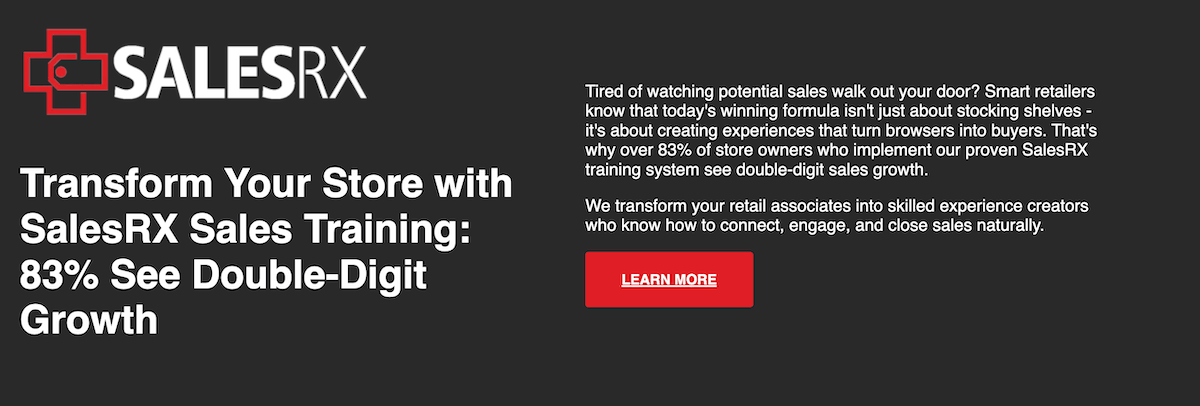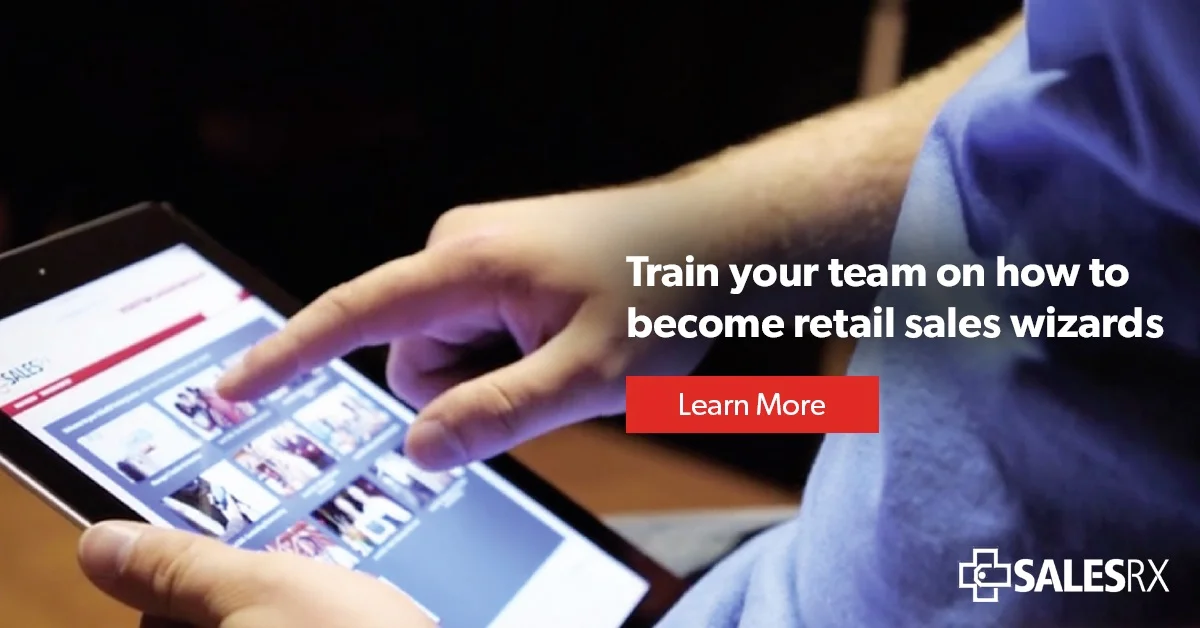Online Retail Sales Training
It is great to have a retail sales strategy that stresses the need for sales training programs to engage every shopper to get every sale, but the devil is in the details.
How are you going to make sure every store associate understands your unified selling process? How do you get them to adopt it as their own, and what is necessary to make retail sales training a success?
Online training holds the potential to give you all of that as well as higher conversions and higher units per transaction. This post will serve as a primer, an in-depth look at all that goes into making a online retail sales training program successful.

SUBSCRIBE TO RETAILRX
The Retail Newsletter over 100,000 Retail Pros read
Insights and tipsRetail Industry News
Out Weekly
Get it in your inbox.
By entering your email you expressly consent to receive other resources to help you improve your marketing efforts.
|
|
"This is a wake-up call for traditional mattress chains: The 1960s model doesn’t work anymore," said Bob Phibbs, chief executive of New York-based consultancy the Retail Doctor. "The traditional mattress-buying experience didn’t make people feel like they mattered. It made them feel used." |
|
|
As for Nike, "they hit it out of the park with the Kaepernick ad," said Bob Phibbs. "This ad is completely in line with who Nike is and what they stand for. That authenticity resonated and will continue to resonate with their customers." |
|
|
"People still want to write retail apocalypse but it’s not happening," said Bob Phibbs, chief executive officer of New York-based consultancy Retail Doctor. |
What Is Online Retail Sales Training?
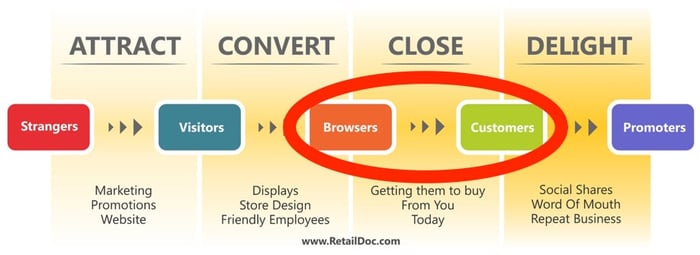
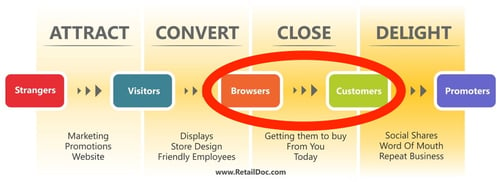
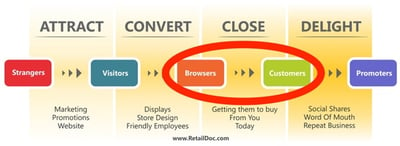
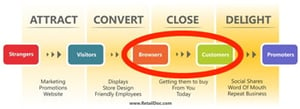
Just like in-person training, online retail sales training is a proven system that covers how to engage a stranger and how to build rapport. Hence, you gain their trust, how to show the product benefits, overcome objections, and sell value over price. The difference is in the delivery method.
Online training scales easily for larger retailers and gives smaller retailers the resources to train each of their associates in a bite-sized manner. It's important to note that one is not better than the other.
In fact, in-person training is essential if you want to truly create long-term relationships with your customers and increase sales in your store.
Why? While online retail sales training has done 90% of the work—what to teach, how to make it engaging, and how to certify a learner—the last 10% has to be in person, with someone inspecting what is expected, just like in-person training.
There is no set-and-forget training, either online or in person. Imagine your child taking piano lessons with no one listening for wrong notes or your spouse opening a bakery without anyone tasting their creations.
No training will work unless you monitor and coach the learners - especially at the beginning.
That's because no one likes to be trained.
Training means change. It means being held accountable. It means doing something in a new way where you might fail. And for that reason, many employees fear they won't be successful at it and therefore fear being fired.
Many retailers won't schedule the follow-up to ensure the sales employees know exactly how to improvise and where to follow the plan.
Those retailers are doomed to failure. The old saw is still true: Those who fail to plan, plan to fail.
With traffic and conversions going down across the board for brick-and-mortar retailers everywhere, it is easy to want to do something—even if it is inadequate.
But half-hearted attempts won't work.
Online retail sales training is not a popularity contest.
It is not a democracy.
It is an operating system.
Whether you use my SalesRX streaming training program with proven results or a lesser version, you can't ask your crew what they think about buying a retail training program. They'll poke holes in whatever you show them and maintain they are already doing awesome.
Except if you're reading this, you know they aren't.
Retail has to be more than a transaction in a store. It is about creating an exceptional experience.
More time with a customer does not equal more sales. You hit diminishing returns on time if it is not productive and engaging for your associates and shoppers.
This brings us back to the training system, ensuring that anyone on your sales floor knows exactly where they are in a sale, what they must accomplish at each stage, and where they are going next. Oh, and yes, while you may have a sales trainer, they may not be well-trained in implementing a training program. Couple that with employee turnover, and store managers are often tasked with moving merchandise, not modeling proven sales techniques.
Getting it right takes work and time.
And that's the great thing about online retail sales training- you only have to schedule it for about 10 minutes per week, so there's minimal time off the floor. That's right, minutes, not hours.
Mastery comes in the days after the bite-sized lessons when your associates practice role-playing and using what they've learned with actual customers. Their goal is to prove they didn't just get it right once on a test but that they've practiced it so well that they can't get it wrong on the sales floor.
It’s like that old football saying: When they’re all reading from the same playbook, they are bound to get the touchdowns.
Most retailers look to online learning management systems (LMS) for cost efficiencies, but it isn’t just cheaper to train someone online than in person; in many ways, it is better.
With online training, you can view certification reports to verify that someone took the training and understood the material. That is hard to assess in person, and even if you could, it would be cost-prohibitive, as each person may have to have the materials explained repeatedly.
Online retail training can cost nothing to $50 per person per month. But that old adage you get what you pay for has never been truer.




But they come with both pluses and minuses...
On the pro side:
Online retail sales training can be delivered anywhere in the world at any time, allowing for a flexible training program
No matter their current level of experience, anyone who has to sell can learn from a wide range of online retail sales training programs powered by intuitive interfaces designed for ease of use. Anyone should be able to start training immediately without a lot of explanation.
You can ask questions and receive answers in real-time.
Specialized modules will specifically meet the needs of sales managers so they can coach online sales training and make it stick.
The best online training programs have comprehensive tracking and reporting tools, allowing management to see how their employees are faring at a glance. They can also view who has been certified by completing the training and who has not.
On the con side:
You'll need a laptop, desktop computer, or tablet, earphones, and a comfortable place for employees to gather off the sales floor.
Often, the training is dull and does not adequately teach the store associate what he or she needs to know to make a sale.




On the opportunity side, you have:
Face-to-face training, which is ultimately where you want your associates to excel—face-to-face conversions
When someone from the outside, with a background in training and a curiosity about how individuals learn, delivers the training, the associate does not question it because it has third-party credibility; they believe it better.
Training can be more effective because it can immediately be corrected, explained, and rewarded.
A great sales trainer is easily understood, engaging, and makes time pass quickly. It can also be bundled online into your own sales academy.
The stumbling blocks of in-person retail sales training include:
- It can be difficult to pull many people off the floor or to another location without closing the store
- Company trainers may show up to train several employees, but due to unexpected schedule changes, those employees have to cover the sales floor. This leaves your employee training as a nice-to-know, not a compelling foundation for competing with online retailers.
- The training program can be a firehose of information that is hard to remember.
- Employees used to standing all day find sitting for long periods uncomfortable.
- Unless you have a great trainer, the time can go by slowly with little to show.
So, as you consider how you’ll deliver training, you might wonder why it matters.
Without a retail selling strategy, your employees will most likely wing it. They’ll do what they’ve seen and heard in stores, big and small. They’ll ask the same worst greetings to your shoppers:
-
Can I help you?
-
How are you doing today?
-
Looking for something special?
-
Do you have a budget?
Why are those so bad?
Because you're not building rapport or long-term relationships with one-word answers.
Some retailers still try to use the old sales-y introduction by reaching out their hand and saying, “Hi, I’m (first name), and you are?” but that technique is trying to force a shopper to extend their hand and be friendly.
That friendliness only comes from the salesperson’s ability to build trust in a genuine manner.
That’s why a selling strategy is so important; it minimizes the lame questions while maximizing the right ones to get engagement and buy-in from the shopper. Quite simply…
They have to like you before you can pitch them.
There is nothing a shopper needs in your brick-and-mortar store that they can’t order online.
Is Retail Sales Training Like Product Knowledge Training?
A retail sales training program is behavioral training. It is designed to change how one person responds to another in a brick-and-mortar store. Many people don’t get this.
Product or technical training is passive and concerned with facts. The learner has to do nothing.
For example, product training on a piano would involve the number of keys, the science of a C Major scale, differences in sounding board materials, tuning requirements, and the like. You would not have to be in front of a piano.
However, with behavioral training, the learner must actively act, which requires practice.
Behavioral training on a piano would involve learning how to hold your hands, crossover your fingers on a two-octave scale, and other related skills.
While you can understand its facts, the key to mastery is practice.
You take online retail sales training to understand what to do, but mastery only comes with consistent practice. You must interface with humans to develop muscle memory and become welcoming; you must choose the right words to put in your mouth and be able to micro-adjust on the fly to adapt to each stranger.
Both types of learning need to be understood clearly, and the learners need to know why each type of training is important.
Your retail sales training must be designed to include, at minimum, how to approach a shopper, what to say and not say at the outset, how to use probing questions, how to present the product's benefits over its features, and how to suggestively sell one additional item that makes that first purchase more complete.
Online retail sales training has to show learners they are gaining life skills. View an excerpt below.
One difference between online training and in-person training is that online training typically offers an off-the-shelf solution with one set program. In-person training can offer a customized program that is only concerned with your specific store. But remember that customization comes at a much higher cost. You probably already have product-specific training from your vendors, so that’s not what you should be concerned with creating, at least initially.
At a minimum, training the soft skills of selling covers everything from how to listen to a shopper, how to greet a customer, which words to use and which to avoid, how to build rapport before pitching a product, how to show and tell that product to a specific shopper, how to close a sale by overcoming objections, and how to follow up.
You can develop your own retail sales training program. Still, it is impractical for many because the creation and rollout of such a program from start to finish could take anywhere from eight to ten months and possibly as long as a couple of years until it is all scripted, filmed, beta-tested in the field, and gets final approvals from the multitude of people who each want to find a way to tweak it.
Even if you choose some of the self-service platforms, what works for one salesperson often doesn’t work for another, so choosing what to train and who will do it often becomes a stumbling block to success.
That’s why my online training program, SalesRX, is the best choice for your retail business. Tens of thousands of dollars have been spent, and the content is based on my proven system that trains employees to engage a stranger, build rapport, and close the sale. It has been vetted by hundreds of brands and thousands of users on sales floors around the world. And it takes just minutes, not years, to sign up and begin training your sales reps.
When you sign up, you’ll realize one of the key values of online training: it takes very little off-floor time. The practice of new skills can come at any time there is a down moment, yielding you a higher rate of return.
Why is now the time for retail sales training? Watch the video.
Some versions of online training still feature a speaker in front of a live audience and shoehorn that multi-hour presentation into a training package.
Attention spans have become shorter.
Attention spans have become shorter. Most training videos created over two years ago were frequently 30 minutes or longer. Now, even a five-minute video pushes the attention span of most learners. If you don’t interrupt the lesson and give them a question to answer, you’ll be lucky if they pay attention for even two minutes. And that will make it harder for your retail managers to get buy-in from your staff.
See how interactivity keeps a learner engaged in this preview from the How to add-on to a sale lesson in SalesRX.
You had to be there won’t cut it.
A speech is a very different type of communication. What may work in front of a live audience often falls flat to an online learner because there is no context.
Content has to be clear and detailed.
The best online retail sales training programs teach one concept per lesson so a learner can get back on the floor and start using it right away. Trying to drink from a firehose of information in a 30-minute video leads to frustration and doesn’t move the needle of comprehension; in fact, it does just the opposite.
Take The Retail Sales Personality Quiz
No matter your personality type, you can leverage your unique abilities to engage your customers and make better sales. This quiz will not only give you insight into your own type, but will also teach you to recognize, relate to, and connect with the other types to build a solid sales team.
First, let’s get out of the idea that sales training is something to get through. Again, this is behavioral training. You can get through an hour of content online in an hour, but spending that hour just viewing something won’t result in sales.
Remember, comprehension is not the goal of behavioral training; otherwise, every diet you have ever tried would have worked perfectly. The act of changing the way you physically do things is what you are looking to achieve in behavioral training. It’s not until you change how you eat and look at food that you can achieve your original goals for going on a diet.
Retail sales training is not about answering the questions correctly on a test; it is about changing the way your employees interact with your shoppers.
So how much time does that take? When you give employees 2-3 months to master the foundational learning, the heart of SalesRX, you should see UPTs and average sales increase from 3-6 months thereafter.
In order for your training to succeed, you need to devote time to planning exactly how you will bring your team on board, how you will engage retail management, and how you will get a reward commitment from everyone involved in making the new training program a success.
As I’ve said a couple of times now, no training is set and forget. You can set and forget it, but to succeed, the process has to be managed.
Check out this excerpt from the Train-the-Trainer module of SalesRX covering how to correct behavior.
Whatever retail sales training you choose, it will only be as effective as your management and monitoring skills. Sales increases won't magically materialize; you have to practice and role-play.
Is there a good or bad time to start retail sales training? Outside of December, when staff is easily distracted, you can and should start training any time you have the interest and money to do so. Any training your staff gets will influence every interaction they have and potentially close more sales as a result, so don’t wait for the right time. The time is right if you’ve read this far.
As long as you have a Wi-Fi or ethernet connection, you should be able to reliably deliver online training anywhere in the world. Cellular video service eats up a lot of data time and is often unreliable if you get a truly interactive program like SalesRX.
A common mistake in online sales training is thinking that only front-facing employees need it. Yet anyone who manages, as well as anyone in your call center, should also take the training; otherwise, they have no idea what it takes to actually engage shoppers in a new way.
And with all the omnichannel buzz around having the same customer experience in-store as online, you want all spoken communication with your shoppers to be as engaging, whether on the phone or in-store.
The key to getting buy-in from management is to go to the top. Once the owner or CEO is aligned with a vision, they can help make it a reality. Without their enthusiastic support, managers down the organization line can stop or corrupt your goal of training your staff.
Some will still object. Most frequently, those who won’t support retail sales training online see the training budget line item as a drain on their own budget and programs.
The key is to get the whole management team to understand that rising conversions mean rising sales and margins. In short, the initial cost should be amortized quickly. But again, that all depends on buy-in from your team.
The success of your management team’s rollout of a new training program depends on their understanding that it is not bolted on to existing training and it is not just a temporary fix for something you’ll take on a month-to-month trial. It is a change in the very culture of your business.
What’s that change? To become a company focused on constantly developing its employees. More training and sharing of that knowledge leads to new ideas for engaging shoppers, getting more from employees, and—let’s not forget—making your customers raving fans.
As you brainstorm with your management team about bringing training to your organization, you must start by answering the whys:
- Why are we doing this?
- Why are our conversions down?
- Why are our margins down?
- Why is our turnover high?
Why are there so few 5-star reviews of our business?
Their answers will inevitably bring you back to the training you have or have not given your employees, the hit-or-miss experience of shoppers in your store, and an overall culture that is hard to define.
A huge reason to adopt retail sales training is to help solve the question of how to prioritize the human customer in the age of machines.
Once all members of your management team see the need for a new store culture, brainstorm the perfect customer experience. Don’t aim for pie-in-the-sky generalities like we’ll value every guest, but state exactly what your new customer experience should look like to a shopper.
Once everyone has a clear picture of where you want to go, understand that if you could get there on your own, you would. Realize you must find a retail sales training program that can get you there, and everyone in your organization must take it.
Make sure anyone involved in the process understands what is in it for them, for your associates, and, most importantly, for your customers.
Brick-and-mortar retailers, from the top luxury brands to the Main Street staples, are fighting to survive diminished shoppers' demand, fewer shoppers driving to stores, and the scourge of online discounters.
Online retail sales training should have the ability to train one-to-one so each learner can take as long as they need to get the information; individuals can watch it over and over again - if necessary - until they get it right.
SalesRX, my online learning program, is interactive, so depending on each learner’s individual answers, they go down a different learning tree to get the same training. It’s as close as you can get to personal one-to-one training.
Again, old online training was nothing more than a series of videos people would show to a group that forced everyone to be in the room simultaneously.
Online training has come a long way. Employees can train off the floor using a laptop, desktop, or tablet at various times.
A smart manager will not let them take the training when needed on the floor. Breaking their concentration short-circuits the learning. Therefore, ensure you have adequate coverage so your learners can be off the floor and uninterrupted.
Smart managers also realize that employees need time and practice to master the skills on the sales floor. Therefore, do not assign the whole training all at once but break it up into weekly bits and grant associates enough time to practice so that it sticks.
Online retail sales training breaks down a comprehensive selling process into packets of information that can readily be assimilated. But make no mistake, it still can be a lot of education.
You can’t leave too much time between learning and having to recall or they’ll have a harder time accessing the information when needed.
Unless the new behavioral learning is practiced and used, the learning memory will fade.
But as it turns out, that’s not all bad; forgetting can help gain expertise. If you expose the learners to the material again, they can master it.
You develop a deeper understanding when you relearn something you couldn’t recall. That’s because to remember something important, you have to keep experiencing it.
And when you re-engage an area of the brain to recall something, you have a greater perspective and can spot connections better. So practice is necessary both at the beginning and when the learner can’t recall or doesn’t use the learning.
When the training is delivered online, it is easy to send them through it again—for just one lesson or the entire course.
In fact, many SalesRX clients routinely have us wipe the training, so their associates have to retake the lessons. Those retailers report that learners discover new things every time they repeat it and do even better. It isn’t seen as punishment or remediation—simply as re-exposure to gain mastery.
That repetition would be impractical for in-person retail sales training, yet it costs nothing more online.
Two of the most common concerns retailers have before offering training are whether it will work and whether they will use it. Well, they won’t use it unless you explain metrics and expectations to them at the outset with follow-up.
Do not assign the coursework as homework or give a bonus when it is completed. This is counterproductive as it models you need to get through this. The learner could power through the entire training in one night yet learn nothing.
That’s why whatever training you select should have various measurement tools to clearly see how many times a learner logs in and their completion rate.
Once you have chosen your retail sales training online provider - and I hope it’s me - you have to think of how you will coach your new learners, what experiences you will give them to try out new skills as they are adopted, how you’ll know your training is succeeding, and how they can share success stories between themselves.
I had a woman who called me many months after beginning SalesRX to tell me, “Since using your program, our customers have all gotten nicer.” I replied, “Your customers didn’t get nicer – you did.”
That happens when everyone is aligned with a new vision of what a customer experience can be in your store. It takes work and time, but what’s the alternative?
Read The Complete Buyers Guide For Online Retail Sales Training
How will online retail sales training help with your challenges? This guide is meant for retailers who are aware of the challenges they face, and are searching for answers to their most common employee training problems. Find out if online training is right for you with this guide.
We’ve already said you can get retail sales training online for anything from zero to over $50 per person per month, and you get what you pay for.
Quite simply, there is nothing you can do in your retail business that has the potential to touch each and every customer day in and day out as a good retail sales training program.
Wouldn’t you pay $200 monthly to get $1000 more in sales, see your close rate double, and improve your UPT? It seems obvious, doesn’t it? The potential upside to your return on investment (ROI) is huge as long as you drive the process.
Yet many retailers leave training as an afterthought, an option somewhere between having their carpet cleaned and their parking lot blacktop refinished – when I notice something wrong, I’ll fix it
But You Can't Wait Until You're At Death's Door.
So many retailers don’t value training because they haven’t experienced what training can do for them. Those who come to retail training easily have come from a culture where training is a way of life and where money is spent to develop employees in a drive to differentiate from competitors by the quality of service given to their customers.
They see the return on investment in multiple ways, including lower employee turnover, fewer mistakes, higher conversions, happier associates, and satisfied customers.
The best online retail sales training program will be able to show you the number of pass/fails on a given course or lesson. That helps you see how seriously your learners take the training. It is not uncommon to discover many failures in the early lessons as associates become acquainted with the training process and realize they will be held accountable.
That’s something in-person training has a tougher time measuring because there are rarely any comprehension evaluations or tools provided throughout the learning. This gives retail sales training online a leg up because it provides these tools, which other training does not. You should also use your POS to measure your training efforts; you should compare your key performance indicators (KPIs) like average check, average number of items per check, and dollars sold per hour worked and reward as those KPIs rise.
The reporting functions in your online retail sales training program are also important. This video explains the SalesRX certification program.
If you’ve read this far, you might have analyzed your sales training efforts and concluded that you’re not getting the desired results.
What steps can you take to improve your outcomes?
Many training programs fail because they don’t follow the steps outlined in this post, there is no buy-in from the top, insufficient explanation of why you’re doing it to the managers, expectations are not set, and no one inspects what is expected.
The most obvious reason retail sales training - in-person or online - fails is that the content was not good from the start and probably formatted cheaply.
Remember, we're talking culture change here.
Cultural change requires the utmost planning and execution of the content. The good news is that an online retail sales training program like mine has been vetted by thousands of retailers and tens of thousands of learners, so you know the content won’t be a problem when you buy it.
Even if your retail training program is working, your goal is to create a culture of constant learning about human beings—not just products—so always look for examples in movies, other stores, or online searches for new ways to describe exceptional retail customer service.
Change is always scary to people who are charged to implement it without their consent or advice, so proactively bring as many people into the discussion about the need for change and listen to ideas to ensure you get buy-in early.
Even with buy-in, common objections to training from your staff might include:
- It will take too much time off the floor. Just 10 minutes is all you need per week.
- Online videos are boring. People watch cat videos over and over. Videos are entertaining and feel less like work than a workbook.
- It's not product-specific. Retail sales training is about the soft skills of building rapport and engaging a shopper, regardless of product. It only adds to your existing knowledge base.
- We've tried training before, and it didn't work. That's why you've taken pains to choose the best program that addresses every concern your staff has mentioned.
- It will eliminate our trainer's job. Nope, this will free them from teaching the content so they can focus on mastery.
- We have seasoned employees who aren’t computer-savvy. They'll be fine if they can log in to their Facebook account or send an email.
- Online learning is impersonal; my employees prefer to learn in person. It isn’t either/or—you still need someone on the floor to make sure the learner is using what is taught, answer their questions, and encourage them to try new skills.
Due to its scalability, online retail sales training is a cheaper way to make an impact. It will also ensure better use of employee training time and improved customer service consistency among all associates at all locations.
But here’s the biggest key to overcoming employee objections: it ensures job stability. Make sure everyone understands this cultural change helps your store become a destination of choice for shoppers. It helps thwart the onslaught of online retailers and the threat to the viability of your entire organization.
Most retailers carry various products in their brick-and-mortar stores … but so do their competitors.
The old price and promotion levers simply aren’t working to increase retail sales.
And now when shoppers are most likely looking down to their smartphones for help, you must concentrate on making the human in front of you feel first in this age of machines.
The only way to do that in your brick-and-mortar store is to create an exceptional customer shopping experience.
Online retail sales training allows you to engage, build rapport, and become your shoppers’ trusted advisor. It delivers the how-to aspect for every member of your crew in the exact same way, allowing everyone to be consistent from shift to shift, from store to store, and from state to state. Nothing is left to chance.
Once your employees master how to engage a stranger and build rapport, your managers can carefully give up control of each employee. And that’s a good thing. No one wants a supervisor who constantly nags.
The good thing about ceding control is that it requires managers to develop a certain tolerance for mistakes. When they do this, rather than taking harsh corrective action and criticizing, your management team learns how to treat employee mistakes as opportunities to facilitate learning, and everyone wins.
Online retail sales training scales for large organizations and is affordable for smaller retailers. Other benefits are:
- Convenience. It is always on.
- Ease of Use. There are no manuals or DVDs to lose or update; everything is in the cloud.
- Adaptability. From your newest part-timer to seasoned full-timer associate, everyone gets the same information.
- Train-the-Trainer. Your store managers should go through the training courses before your retail sales associates so they know what is being taught.
- Better Retention. With bite-sized lessons, there is less to learn off the floor.
- Immediate Results and Feedback. Testing functions allow learners to repeat and quickly learn from any gaps in their comprehension.
- It’s Visual. Our brains pick up 90% of the information we see. We process visuals 60,000 times faster than we can process text.
With online sales training programs, there still has to be an element of in-person training to coach and role-play the new skills. You can’t set and forget any training, so remember to inspect what you expect.
When you show your salespeople you are willing to invest in their potential with training, you convey your confidence and trust. That allows them to sell confidently and prevents any employee from simply winging it.
In sum, when you deliver online retail sales training, you can better measure your training goals, improve your customer service, and achieve coachable results.
- 1. Introduction: What Is Online Retail Sales Training?
- 2. Why Is Cost So Important In Online Retail Sales Training?
- 3. Online Retail Sales Training Courses Are A Huge Resource In the Digital World Colleagu
- 4. In-person retail sales training has its own pros and cons
- 5. What is Online Retail Sales Training and What Should It Involve?
- 6. What's So Bad About Live Videos Used For Online Training? Plenty.
- 7. So What Does Work And How Much Training Time Does Online Retail Sales Training Take?
- 8. How and When Should I Get Management Involved?
- 9. How Much Should Retail Sales Training Online Cost?
- 10. Retail Sales Training Online - Measuring Your Success
- 11. Improving Your Use Of Online Retail Sales Training
- 12. Overcoming Challenges in Online Retail Sales Training
- 13. Conclusion: Retail Sales Training Online; Convenient, Consistent & Affordable
Read More About Online Retail Sales Training
Related Blog Posts:
- Here’s Proof The Best Online Retail Sales Training Program Works...Well Mine Anyways
- The Case For SalesRX, My Online Retail Sales Training Certification
- How To Justify The Expense Of Retail Sales Training For Your Staff And Why
- How The Best Training Solution For Your Retail Brand Might Be An Online Campus
- Is Virtual Online Retail Sales Training For You?
- 9 Benefits of Using Online Retail Sales Training
- How To Determine The ROI Of A Retail Sales Training Program
- Is SalesRX Online Retail Sales Training Right For My Stores?
Live Webinar with Bob
If you're not sure if SalesRX is right for you, there's a good chance you're not ready for SalesRX. You need to first learn the five shifts brands use to stop hemorrhaging retail sales to online store owners. This free on-demand training is jam-packed with 100% actionable tactics PROVEN to increase retail sales.
You can keep losing business to Amazon and the other Ship-to-Self crowd… or you can get an unstoppable strategy through my on-demand training in 30 minutes or less.

